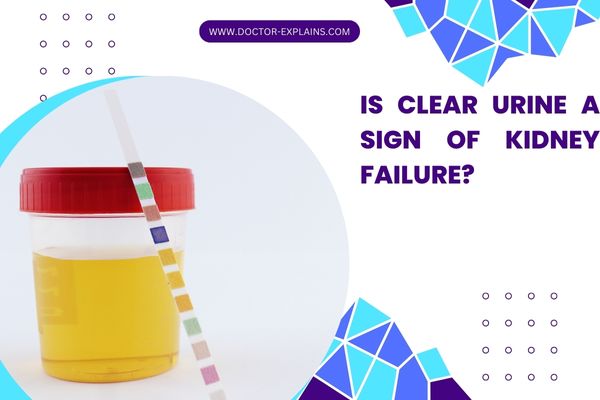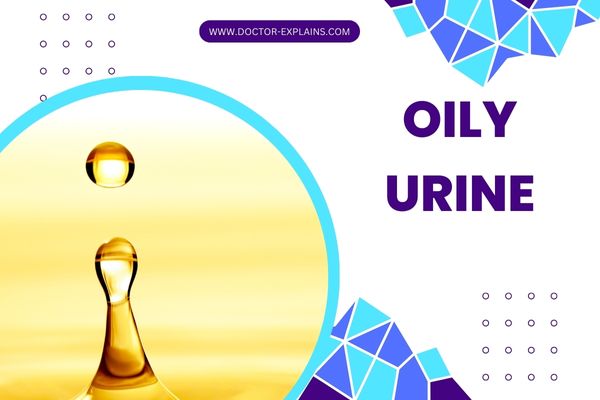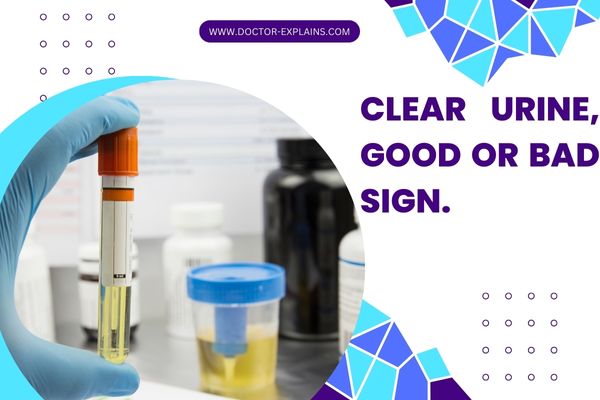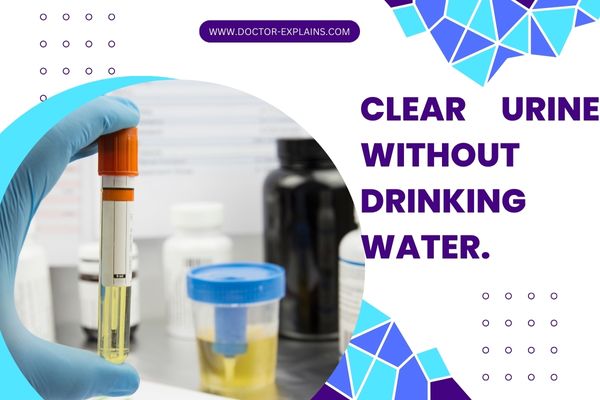Clear Urine: 6 Causes & When to Worry
Our content is not intended nor recommended as a substitute for medical advice by your doctor. Use for informational purposes only.
Clear urine is a term that usually refers to “transparent,” “lighter-colored,” “colorless,” or “pale-colored urine.” Under normal circumstances, the urine is clear (not turbid), but people often refer to light-colored or white, water-like urine as (clear urine).
In this article, You will learn about the most common causes of clear or pale-colored urine.
The most common cause of lighter-colored or clear urine is overhydration. Other causes include diabetes, Excess alcohol, caffeine, medications, pregnancy, and others.
Less frequent causes of clear urine include diabetes insipidus, hypercalcemia, kidney failure (and healing from kidney disease), Cushing’s syndrome, and excess IV fluids.

1. Over-hydration (The most cause).
Drinking too much water or other beverages and eating high-water fruits (such as watermelons) may lead to clear or light-colored transparent urine.
This is the most common cause of occasional clear urine. Clear urine (like water) occurs due to diluting the yellow pigments, making your pee very light in color.
Common circumstances:
-
- Extreme thirst, followed by drinking large amounts of water.
-
- Habitual drinking of water without being thirsty.
- Too many fruit juices.
- Drinking too much alcohol or beer.
- Too much soda or carbonated drinks.
- Eating Too many high-water fruits (such as watermelons, oranges, etc.).
Clear urine doesn’t necessarily mean a kidney problem. It may be due to simple causes such as excess water or other fluids. Urine is supposed to revert to its stander yellow color within a few hours or a day.
2. Excess caffeine or alcohol.
Caffeine and clear urine:
Caffeine is a potent diuretic; drinking coffee will increase your urine output and may cause clear urine without drinking water. The effect of caffeine is dose-dependent; The more caffeine you drink, the more polyuria and clear water-like urine you will get.
Alcohol and clear urine.
Alcohols with high alcohol consumption increase the amount of urine, leading to clear or white urine. Also, Binge drinking of low-alcohol or non-alcoholic beer can produce the same effect (due to over-hydration).
3. Medications.
Many medications are intended to increase urine volume (diuretics). Also, some medications may lead to polyuria as a collateral effect.
Medications that increase urine output produce pale yellow or clear white urine according to its potency and dose.
-
- Diuretics such as furosemide (Lasix@), Aldactone, hydrochlorothiazide etc.
-
- Some antihypertensive medications include Cardura, Amlodipine (Norvasc®), and Felodipine (Plendil®).
- Some diabetes medications such as Dapagliflozin (Farxiga), canagliflozin (Invokana®), and empagliflozin (Jardiance).
- Tamsulosin (Flomax®) used for the treatment of being prostatic hypertrophy (BPH).
- Antidepressants such as escitalopram, sertraline, and fluoxetine.
- Benzodiazepines (for treatment of insomnia and anxiety) such as diazepam (Valium®).
4. Uncontrolled diabetes.
High blood sugar causes osmotic diuresis:
Diabetes mellitus refers to the increase in blood sugar (glucose) levels. In addition, patients with undiagnosed diabetes often present with polyuria (frequent urination of large amounts of clear urine without drinking water), thirst sensation, and progressive weight loss.
Also, clear urine may mean uncontrolled diabetes if you are known to be diabetic. High blood sugar diabetes causes polyuria because your body excretes excess sugar through the kidneys.
As the excess blood glucose passes into the urine, it causes the urine volume to increase and the color of pee to pale yellow or clear white (glucose draws more water from the body into the urine).
DKA and clear urine.
Peeing a lot of clear urine in a patient with type 1 diabetes (insulin-dependent diabetes typically affecting young adults) may mean impending diabetic ketoacidosis (DKA), a medical emergency. Consult your doctor if you notice clear, frequent urine with other symptoms such as shortness of breath, abdominal pain, or vomiting.
Diabetic nephropathy and clear urine.
Long-lasting diabetes (especially if it is poorly controlled) can cause permanent damage to the kidney up to kidney failure.
Patients with diabetic nephropathy may have abnormal kidney function, protein in the urine, and clear foamy urine. Learn more.
Treatment of clear urine due to diabetes:
The most important aspect of controlling clear urine is controlling blood sugar levels. Once the blood glucose levels return to normal, polyuria and clear urine return to their normal color.
Complicated diabetes conditions such as DKA and kidney disease must be reported to your doctor.
5. Pregnancy.
The kidney is more active during pregnancy, and your overall body fluids increase, with a subsequent increase in urine filtration through the kidney (glomerular filtration rate increases by about 50% during pregnancy).
So, pregnant women’s urine may appear clearer or more pale than usual due to excess excretion.
Treatment of clear urine during pregnancy:
No treatment is needed for clear urine during pregnancy unless you have other symptoms such as very frequent urination of a lot of urine, extreme thirst, or
6. Less frequent Causes:
A. Diabetes Insipidus.
The amount of urine excreted is controlled by a hormone secreted called the Antidiuretic hormone (ADH). The hormone is secreted by the pituitary gland inside the brain and acts on a specific receptor in the kidney to prevent excess urine excretion.
Polyuria (excess clear urine) occurs when the ADH hormones are decreased (central diabetes insipidus) or become ineffective due to defects in the kidney receptors (nephrogenic diabetes insipidus). Learn More.
B. Hypercalcemia.
Excess calcium, as with parathyroid tumors, malignancy (multiple myeloma) causes excess, diluted urine that appears clear.
C. Kidney failure.
Patients with acute or chronic kidney failure and during the healing stage of acute kidney injury may develop polyuria (large volume, clear or water-like urine).
D. Cushing’s disease.
Cushing’s disease is typically caused by an adrenal gland tumor secreting excess corticosteroids. As a result, patients with Cushing’s disease usually have polyuria and clear urine.
E. Excess IV fluids.
Excess intravenous fluid during hospital or emergency room visits may lead to polyuria and clear urine. Also, patients who have brain problems such as cerebral hemorrhage may b (brain dehydration measures using mannitol or hypertonic saline)
Also, patients who have brain problems such as cerebral hemorrhage may be treated with brain dehydration measures (using mannitol or hypertonic saline) which typically lead to polyuria and transparent urine.
When to worry?
See a doctor for clear urine if it is associated with one or more of the following:
-
- Polyuria (large urine volume) is persistent for several days without excess fluid intake.
- Persistent clear urine for days or weeks.
- Recurrent thirst sensation.
-
- Burning urination or presence of urethral or kidney pain.
- Foamy urine.
- Abdominal pain, nausea, or vomiting.
-
- Fever.
- Unexplained hunger (polyphagia).
- Unexplained weight loss.
FAQ:
Is clear urine a good or bad sign?
Most clear (pale or white) urine cases are due to benign causes such as drinking excess water. Therefore, it is generally not considered a bad sign unless associated with other symptoms, such as extreme thirst, persistent large-volume urine, abdominal pain, or burning urination.
Can you have UTI with clear urine?
Yes, you can clear urine during UTI. Cloudy urine only appears in severe cases of UTI (due to excess pus or blood in urine). The urine typically appears clear and normal in mild cases of UTI and cystitis.
What does it mean to have clear urine with frequent urination?
Clear urine and frequent urination usually mean you have polyuria (excess urine). It can be caused by excess hydration or diseases such as diabetes mellitus, diabetes insipidus, excess caffeine, alcohol, medications, pregnancy, etc.
What does it mean to have clear foamy urine?
Clear and foamy urine may mean you have excess protein or a UTI. Consult your doctor if clear and foamy urine is persistent for days or if you have other symptoms such as burning urination, kidney pain, etc.
- Evidence-based
- Written by a doctor.
MD, Internal Medicine and Nephrology specialist.

Dr. Esraa A. MagidAuthor
MORE INSIGHTS





